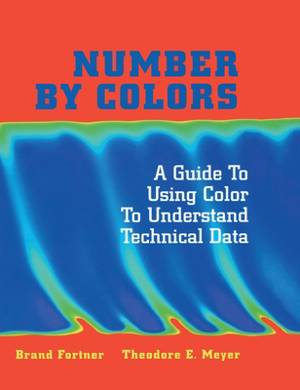
- Retrait en 2 heures
- Assortiment impressionnant
- Paiement sécurisé
- Toujours un magasin près de chez vous
- Retrait gratuit dans votre magasin Club
- 7.000.0000 titres dans notre catalogue
- Payer en toute sécurité
- Toujours un magasin près de chez vous
Number by Colors
A Guide to Using Color to Understand Technical Data
Brand Fortner, T H Meyer, Theodore E Meyer
Livre relié | Anglais
151,45 €
+ 302 points
Format
Description
I: Color Physics, Physiology, Psychology.- 1 Spectral Analysis.- Introduction-Spectral Analysis.- Questions About Spectral Analysis.- Generating Waves.- Constructing a Harmonic Oscillator.- Sine Waves.- Waves in Space.- Sound Waves.- Analyzing Waves.- Power Spectra.- Calculating Power Spectra.- Light waves.- Electromagnetic Radiation.- Photons.- Light Definitions.- Summary-Spectral Analysis.- Responses to Questions About Spectral Analysis.- References.- 2 Eye, Ear, and Brain.- Introduction-Eye, Ear, and Brain.- Questions About Eye, Ear, and Brain.- The Ear-Sensing Sound.- The Physiology of the Ear.- The Five Dimensions of Sound.- The 3D + S +t Field.- The Spatial (X, Y) Dimensions.- The Depth (Z) Dimension.- The Sound Dimension.- The Time (t) Dimension.- The Ear-Summary.- The Eye-Sensing Light.- Sensing Light.- The Physiology of the Eye.- The Parts of the Eye.- The Photosensors: Rods and Cones.- The Visual Pathway and the Lateral Geniculate Nucleus.- The Five Dimensions of Light.- The 3D + C + t Field.- The Spatial (X, Y) Dimensions.- The Depth (Z) Dimension.- The Time (t) Dimension.- The Light Dimension.- Summary-The Eye and the Brain.- Responses to Questions About Eye, Ear, and Brain.- References.- 3 Light Spectra to RGB.- Introduction-Light Spectra to RGB.- Questions About Light Spectra to RGB.- Sensing the Light Spectra.- Sensing Reflected Light.- Color Constancy.- Colorblindness.- Summary-Light Spectra to RGB.- Responses to Questions About Light Spectra to RGB.- References.- 4 Hue, Saturation, Intensity.- Introduction-Hue, Saturation, Intensity.- Questions About Hue, Saturation, Intensity.- Dueling Theories of Color Perception.- The Young-Helmholtz Theory.- The Herring Theory.- The Modern Synthesis.- Defining Hue, Saturation, Intensity.- Intensity.- Intensity, Brightness, Reflectivity.- Perception Versus Physics.- Old Movies.- Hue.- Saturation.- A Laser and Floodlight.- Non-Rainbow Colors.- A Missing Pure Hue.- Brown.- Color Temperature.- When RGB, When HSI?.- Producing Colors in RGB.- Describing Colors in HSI.- Summary-Defining Colors.- Responses to Questions About Hue, Saturation, Intensity.- References.- II: Color Technology.- 5 Defining Colors-The CIE Color Diagram.- Introduction-The CIE Color Diagram.- Questions for Defining Colors-The CIE Color Diagram.- From Three Dimensions to Two.- The Color Cube.- The Color Circle and Color Triangle.- Selecting the Primary Colors.- Response Curves for Color Cube.- Light Spectra for Color Cube.- The CIE 1931 Diagram.- Why X, Y, Z?.- CIE 1976.- Describing and Mixing Colors on the CIE.- Describing Colors on the CIE.- Mixing Colors on the CIE.- Primary Colors on the CIE.- More Adventures on the CIE.- White Points.- Colorblindness.- What about Intensity?.- What the CIE Cannot Do.- Reproducing the CIE.- Summary.- Responses to Questions for the CIE Color Diagram.- References.- 6 Defining Colors-Color Models.- Introduction-Defining Colors-Color Models.- Questions for Color Models.- Additive Versus Subtractive Color Models.- Two Greens Make a Green.- Two Greens Make a Black.- Cyan and Yellow Make Green.- Making Pink.- Further Adventures of Subtractive Color.- Complementary Colors and the Color Circle.- Why White and Red make Pink.- Subtractive Colors on the CIE.- Subtractive Primaries.- The Color Models.- The RGB Color Model.- The CMY and CMYK Color Models.- The RYB Color Model.- The YIQ Color Model.- The HSI, HSV, HSB, and HLS Color Models.- Summary.- Responses to Questions.- References.- 7 Reproducing Colors-Fundamentals.- Introduction-Reproducing Colors.- Questions About Reproducing Colors-Fundamentals.- Pixels.- Pixels and Dots per Inch.- Rectangular Pixels.- Resolutions.- Continuous Versus Discrete.- Spatial and Intensity Resolutions.- Gamma Correction.- The Need for Gamma Correction.- Other Uses for Gamma Correction.- Halftones.- What is a Halftone?.- Making a Halftone.- Lines per Inch and Dots per Inch.- Digital Halftones.- Making Digital Halftones.- How Many Intensities?.- Cluster...
Spécifications
Parties prenantes
- Auteur(s) :
- Editeur:
Contenu
- Nombre de pages :
- 388
- Langue:
- Anglais
Caractéristiques
- EAN:
- 9780387946856
- Date de parution :
- 30-10-96
- Format:
- Livre relié
- Format numérique:
- Genaaid
- Dimensions :
- 196 mm x 240 mm
- Poids :
- 970 g

Seulement chez Librairie Club
+ 302 points sur votre carte client de Librairie Club
Les avis
Nous publions uniquement les avis qui respectent les conditions requises. Consultez nos conditions pour les avis.






